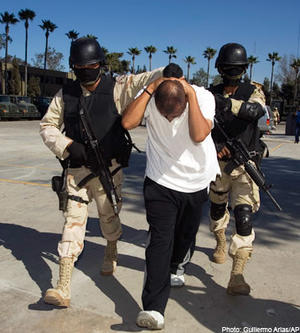Questions and answers on drug-related violence in Mexico
The security situation in Mexico is spiraling out of control; the drug cartels, heretofore content to kill members of rival cartels and the occasional local politician, have now dropped all restraint in their assault on the Mexican state; the cartels are now attacking the Mexican army directly, while no longer bothering to limit collateral damage to the civilian population; the Mexican government, in desperation, has deployed the army so extensively in its anti-drug campaign because it feels the police cannot be trusted; drug cartels with massive resources at their disposal have repeatedly managed to infiltrate the underpaid police, from the grassroots level to the very top; efforts are under way to rebuild the entire structure of the Mexican police force, but the process is expected to take years

Mexican military in law enforcement // Source: thedailybeast.com
Since Mexican president Felipe Calderon launched his crackdown on the drug cartels in December 2006, about 18,000 people are believed to have died. Some 50,000 Mexican troops and federal police are now deployed in the war against the drug cartels. According to Mexican newspaper El Universal, so far this year more than 2,000 people have been killed.
The question is whether the high level of violence is in response to the government’s security operations or a sign that the situation is out of control. The BBC offers some answers.
What is the scale of the violence? If the violence is judged by the number of murders linked to organized crime, the situation appears extremely serious. There were approximately 6,000 such killings in 2008. In 2009 more than 7,000 people were killed. Government officials say that the statistics need to be seen in context, and suggest that nine out of 10 of all the deaths involve people connected with the drug trade, or law enforcement officials.
Where are the worst-hit areas? Is it spreading across Mexico? Mexico’s northern border towns are experiencing the worst of the violence. Ciudad Juarez (just across from El Paso in Texas) is the most violent city, with some 2,100 murders in 2009. So far this year some 500 people have died, not all linked to the drugs gangs by any means. There are also high levels of violence in Michoacan and Guerrero states. Mexico is a large country, and there are still many areas where the serious crime rate is unexceptional.
Why is the violence seemingly increasing? The Mexican government’s position is that the violence, however regrettable, can be seen as a reflection of the success of its policy of taking a hard line against drug-running. It suggests that what we are witnessing is a brutal fight between leaderless cartels for fewer spoils. Others argue that the cartels have become so powerful that they effectively control some parts of the country, and the violence is evidence of their gang law.
President Felipe Calderon has deployed troops. Is this strategy working? Around 50,000 troops and federal police are actively involved in Mexico’s war on drugs. The Mexican government says record amounts of drugs have been seized, and senior cartel leaders jailed or killed in operations. Another consequence has been an explosion of violence, as the drug cartels fight both the army, and each other.
What concerns have been raised about
